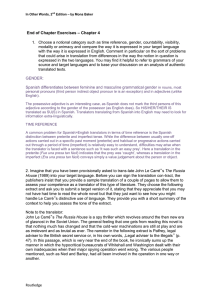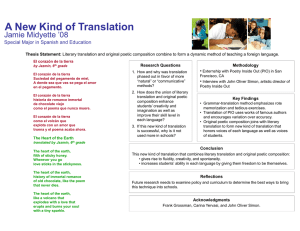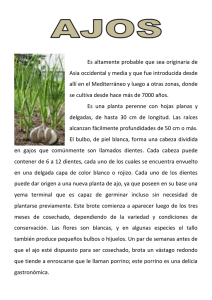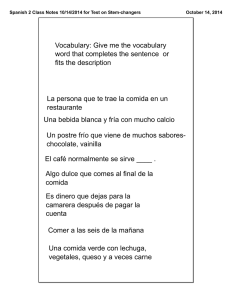A Literary Translation Story - American Translators Association
Anuncio
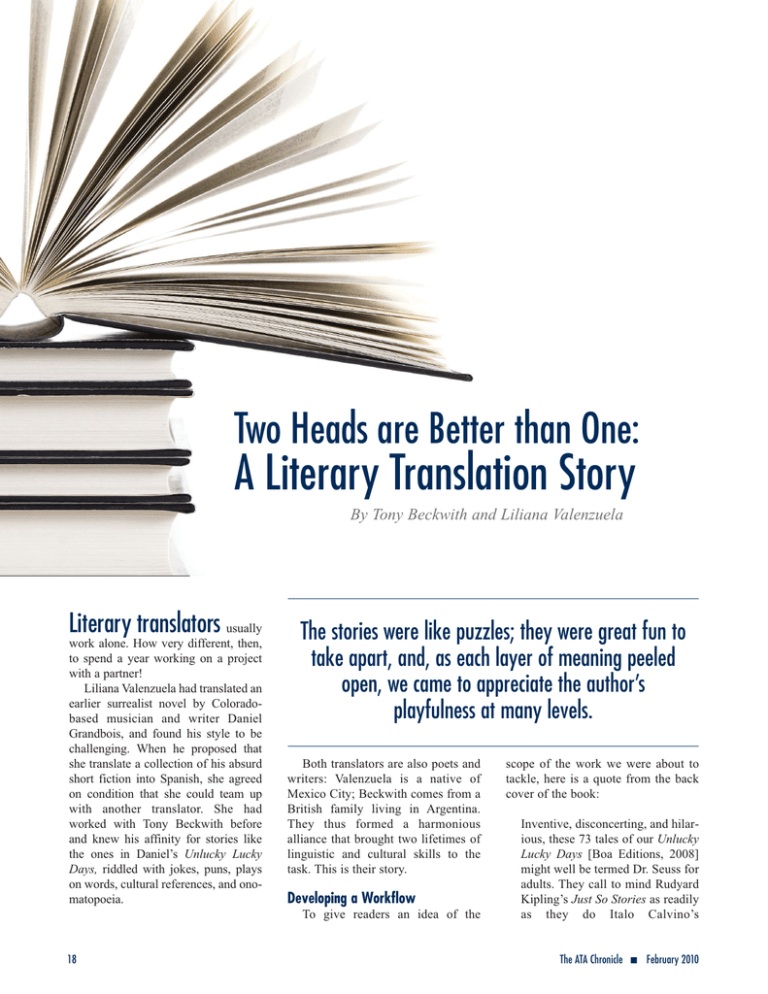
Two Heads are Better than One: A Literary Translation Story By Tony Beckwith and Liliana Valenzuela Literary translators usually work alone. How very different, then, to spend a year working on a project with a partner! Liliana Valenzuela had translated an earlier surrealist novel by Coloradobased musician and writer Daniel Grandbois, and found his style to be challenging. When he proposed that she translate a collection of his absurd short fiction into Spanish, she agreed on condition that she could team up with another translator. She had worked with Tony Beckwith before and knew his affinity for stories like the ones in Daniel’s Unlucky Lucky Days, riddled with jokes, puns, plays on words, cultural references, and onomatopoeia. The stories were like puzzles; they were great fun to take apart, and, as each layer of meaning peeled open, we came to appreciate the author’s playfulness at many levels. Both translators are also poets and writers: Valenzuela is a native of Mexico City; Beckwith comes from a British family living in Argentina. They thus formed a harmonious alliance that brought two lifetimes of linguistic and cultural skills to the task. This is their story. Developing a Workflow To give readers an idea of the 18 scope of the work we were about to tackle, here is a quote from the back cover of the book: Inventive, disconcerting, and hilarious, these 73 tales of our Unlucky Lucky Days [Boa Editions, 2008] might well be termed Dr. Seuss for adults. They call to mind Rudyard Kipling’s Just So Stories as readily as they do Italo Calvino’s The ATA Chronicle n February 2010 Liliana Valenzuela and Tony Beckwith Cosmicomics, Rikki Ducornet’s Butcher’s Tales, and Woody Allen’s most literary writings. Braced on the shoulders of the fabulists, fantasists, absurdists, surrealists, and satirists who came before him, Daniel Grandbois dredges up impossible meanings from the mineral and plant kingdoms, as well as the animal, and serves them to us as if they were nothing more fantastic than a plate of eggs and ham. The book runs to a little over 16,000 words and is divided into seven chapters, each one named for a day of the week. We split the book into two chunks, each taking about 36 stories, or about 8,000 words. We prepared first drafts and exchanged them. We then reviewed each other’s draft, making any proposed revisions using the “track changes” feature in MS Word before sending it back. As the logistics of the project became clearer, we realized we would need a system of some kind to keep track of every change. We wanted to The ATA Chronicle n February 2010 be sure that we created a complete and permanent record that documented every step of the journey. So, the original draft of each story was identified with its translator’s initials. As we revised and returned each draft, every successive revision carried a new suffix that showed how it had evolved. For example: The Yarn The Yarn.tb1 The Yarn.tb1.lv1 The Yarn.tb1.lv1.tb2… Establishing an effective workflow allowed us to concentrate our full attention on the author’s prose. Peeling the Layers We were given a year to finish the project, which seemed like a long time when we signed the contract. The stories are short. Most fit on one page and the longest is only about four pages. But they are often quite complicated, so it took time to unravel the text. Many of the stories are essentially a log of the author’s train of thought, but the tracks run along the fringes of fantasy and the words do not always make much sense if read in a literal, logical way. To translate them, we had to board that same train and describe what we saw through the windows. This first example, which quotes the complete text of one of the stories, sets the stage for the project. Short as it is, the story conveys the surreal quality of this author’s writing. Our translation follows the English. Hat and Rack The man may have mistaken his wife for a hat, but the woman mistook her husband for a hat rack. He wasn’t sure why the hat liked to hang coats on him. She couldn’t answer why the hat rack tried to put her on its crown. When they went to bed, she felt he was all arms. He felt she was distinctly out of place. The few times he submitted to wearing her there, his head swam. Out to dinner, she thought him rigid, while he worried she was liable to sit on · 19 Two Heads are Better than One: A Literary Translation Story Continued any head. Back home, she hung her wet umbrella on him, and he threw her in the closet. Percha y sombrero Si bien el hombre confundió a su esposa con un sombrero, la mujer confundió a su marido con una percha. Él no estaba seguro por qué al sombrero le gustaba colgarle abrigos. Ella no sabía por qué la percha intentaba ponerla en su coronilla. Cuando se iban a acostar, ella sentía que él era todo brazos. Según él, ella estaba sin lugar a dudas fuera de lugar. Las pocas veces que él se sometió a ponérsela allí, sintió un mareo en la cabeza. Cuando salían a cenar, ella lo sentía rígido, mientras que a él le preocupaba que ella fuera a sentarse en cualquier cabeza. De vuelta en casa, ella le colgó el paraguas mojado a él y él la arrojó en el clóset. The stories were like puzzles; they were great fun to take apart, and, as each layer of meaning peeled open, we came to appreciate the author’s playfulness at many levels. Plays on words blended with puns, leading to winks and nudges and gleeful surprises. Here is an example of a challenge created by a touch of onomatopoeia: The Spider King Alas, his queen was too frightened. Her wide eyes could only stare. But instead of squashing her, the baby sort of went ham-MUCK, as it was caught in the king’s bed. El rey araña Pero lamentablemente la reina estaba demasiado atemorizada. Tenía los ojos abiertos como platos. Pero en lugar de aplastarla, la cría 20 A translation is never truly finished; it is merely abandoned when the translator runs out of time or patience. cayó con un ah-MOCOS, al quedar atrapada en la cama del rey. The English ham-MUCK lands splat on the page just as the baby lands in the spider’s web, and we knew we had to come up with something that would convey that idea. In Spanish, the word mocos means snot; mocoso means a snotty-nosed kid. Mocos is also used as a mild expletive (something like “oh, sh—!”), an expression of dissatisfaction to an unwelcome turn of events. Best of all, it has the virtue of sounding somewhat like the MUCK we were trying to duplicate, and manages to retain the approximate sound of hammock and hamaca. Passing Notes As we exchanged revised versions of the stories, we added notes in the margin. We spoke on the phone now and then, and met to discuss specific issues over lunch three or four times during the year. But most of the communication was through the revisions and the notes on our drafts, which might look something like this: The Yarn “Tell us your tale,” a violin spider obliged from its loosely woven web. The yarn stopped in its tracks and laid itself out, as that is how yarns tell their tales. La lana —Desenrédanos tu historia—dijo, complaciente, una araña violín desde su telaraña holgadamente tejida. La lana se detuvo donde estaba y ahí mismo se extendió, pues es así como las lanas desmadejan su historia. Comments in the margin: We’re missing the play on words in “wool/yarn” and “to spin a yarn, to tell a tale”…it’s difficult, maybe impossible to do that in Spanish…how could we say “tell us your tale”—hilar un cuento, desmadejar una historia, desenredar una historia o un chisme…?!!! Translating Cultural Elements The author also entertains readers with his use of cultural references. These are a challenge under almost any circumstances, and this was no exception. Chinese Finger Trap The scattered straw had had enough of the elephant foot’s pranks. It wove itself into a largescale Chinese finger trap and waited, crouching. Buscanovias La paja esparcida ya estaba harta de las travesuras de la pata de elefante. Se tejió a sí misma para formar un buscanovias tamaño The ATA Chronicle n February 2010 extra grande y esperó, agazapada. Tony had never heard of a finger trap in either language, but Liliana was familiar with it and knew the name for it in Mexico. (As many literary translators have discovered, where we grew up really does matter!) Sometimes the stories seemed so surreal to us that we had to allow them to fill our minds with no resistance at all so that we might experience them personally and hopefully understand what the author was seeing in his mind as he wrote. Take, for example, the two opening lines of the following story: The Rope A man opened his barn door and discovered that it no longer led to his barn. It led to his neighbor’s barn, which was identical to his, except it had termites and no cows. La cuerda Un hombre abrió la puerta de su establo y descubrió que ya no conducía a éste. Conducía al establo de su vecino, que era idéntico al suyo, sólo que tenía termitas y no tenía vacas. When we presented our session at ATA’s Annual Conference in New York last October, a translator in the audience made a suggestion that had not occurred to us. She said that she was from Minnesota, where farmers sometimes string a rope from the house to the barn in the winter, so that they can make their way back and forth when everything is covered in snow. Interestingly enough, the author is also originally from Minnesota. In some cases the challenge began with the title, as in the earlier example of the Chinese Finger Trap, and again in: The ATA Chronicle n February 2010 Just as we have our own voices, our translations are our babies, and it requires a significant measure of trust to hand them over to someone else for that final review. Core Truths An apple core was lying awake, which was unusual because most of the time it did its lying in its sleep. It tossed and turned and lost a seed, one of a half dozen black hearts that dreamed of harder skin. La pura verdad El corazón de una manzana se encontraba recostado y despierto, cosa poco usual ya que generalmente se recostaba para dormir. Daba vueltas inquieto y se le desprendió una semilla, uno de media docena de corazones negros que soñaba con una cáscara más dura. In this case, we had to make some hard choices since, as in translating poetry, there was not a great deal of room to move. The play on words involved in “core” and Core Truths works in English but not in Spanish. So we had to decide what to leave in and what to take out. Here, as in other cases, we kept reminding ourselves that the reader would not necessarily have the benefit of the English version to clarify any murky bits. We decided that our first responsibility was to give the Spanish reader an understanding of the essential plot of the story, which quite often meant sacrificing the humor that was bouncing around just below the surface. In the earlier reference to our making notes in the margins of our drafts, The Yarn was used as an example of a challenge that seemed insurmountable. However, with time, and the benefit of two minds asking “what if?” we finally came up with solutions. This encouraged us to revisit stories that we thought we had taken as far as we could. As a result, we occasionally found something that had not been apparent to us earlier in the process. It is no exaggeration to say that a translation is never truly finished; it is merely abandoned when the translator runs out of time or patience. The Yarn “Tell us your tale,” a violin spider obliged from its loosely woven web. The yarn stopped in its tracks and laid itself out, as that is how yarns tell their tales. La lana —Hílanos tu historia—dijo, complaciente, una araña violín desde su telaraña holgadamente tejida. La lana se detuvo donde estaba y ahí mismo se extendió, pues es así como las lanas desenredan la madeja de su historia. In this final example, we find the author playing with the words of the Bard himself, and the challenges here involved quarrying through the stacked strata of a vignette that combines references to classical literature with puns, the so-called lowest form of humor. · 21 Two Heads are Better than One: A Literary Translation Story Continued This Mortal Coil Even had it wished to, the metal spring could not very well shuffle off, as the great playwright seemed to be advising it to do through the voice of his character. The spring was done with and, unless Shakespeare himself or some other of his company wanted to press it down again under a folio or two, it had no tension left to move, much less to shuffle, which might have been beyond its abilities anyway. no podía emprender la retirada, como el gran dramaturgo parecía advertirle por medio de la voz de su personaje. El resorte estaba acabado y, a menos que el mismo Shakespeare o alguien más de su compañía quisiera volver a comprimirlo bajo uno o dos folios, ya no le quedaba más tensión como para moverse, mucho menos para zafarse, lo cual quizá excedía sus habilidades de cualquier manera. Conducting a Final Review El resorte de la mortalidad Aún si lo hubiera deseado, el resorte Once all 73 stories were translated, and revised, and stored in a “Final” file, we realized that there was a final step that we had not considered when we began. Since we had split the stories into two piles and each translated one, we assumed that every story would echo the “voice” of its original translator. If we wanted the final collection to read as one smooth, consistent translation, it would have to be reviewed one last time by just one of us. Liliana recalled that on one occasion when she was struggling to meet a deadline, her mother suggested that she call a colleague to help. Liliana explained that she could not do that because each translator has a unique Quick Tips for the Literary Translator • Listen to the music of the text, to the voice of the author—read it out loud. • Be faithful to your author, but keep in mind your responsibility to the reader. • Start out small—translate a poem or a short story. Most literary translators work best into their native language. • Get feedback from other translators or readers. Small groups are great for this. You can start your own local group, or an online one. • Many literary journals and magazines publish translations. It’s a good place to start. Check out the Literary Press and Magazine Directory. • A literary translation requires at least four passes, checking for different things, like accuracy, format, fluency, style, grammar, punctuation, etc. • Give it some “beauty sleep.” When you let your translation rest for a few days or weeks and then read it with fresh eyes, you will find that things you had not noticed previously will magically pop out. • Some good resources include: American Literary Translators Association www.literarytranslators.org PEN America Center www.pen.org (see their translation model contract) 22 Three Percent A Resource for International Literature at the University of Rochester www.rochester.edu/College/translation/threepercent The ATA Chronicle n February 2010 Tips for a Successful Collaboration • Choose someone with whom you have worked before and whose work you trust. • Create a contract that works for everyone involved and stick to the terms. • Exchange drafts with your partner so you can review each other’s work. • Any proposed changes can be done using the “track changes” feature in MS Word. This makes it easier to document revisions. • Conduct a final review. • Decentralize the decision-making process. If the entire burden for a decision is placed on one individual, he or she is likely to be overwhelmed. If each person is given equal input regarding a particular course of action, problem solving becomes an opportunity to focus on the issues. • Define responsibilities so that each person understands his or her role. • Use constructive criticism rather than emotionally charged discourse to help maintain a positive working atmosphere. As in any true collaboration, it is helpful to check one’s ego at the door. voice, and her mother said, “Oh yes, just as you would notice if someone else did some of your knitting, because it would be tighter or looser than yours.” Exactly! Since Liliana’s dominant language is Spanish, she did the final runthrough and made the final tweaks. Just as we have our own voices, our translations are our babies, and it requires a significant measure of trust to hand them over to someone else for that final review. As in any true collaboration, it is helpful to check one’s ego at the door. Looking back, it was a most satisfactory project on all levels. In many ways it felt like a year-long literary translation workshop with a hands-on component that money cannot usually buy. Which brings us to the final question: what about the matter of remuneration? As we thought about the project, trying to consider it from all angles, it was obvious that when all was said and done we would both have worked on every story, and would have been The ATA Chronicle n February 2010 involved in all the tortuous decisions and revisions behind each and every word in the book. So a fifty-fifty arrangement seemed unrealistic. Fortunately, the author understood this and agreed that we should each receive a fee based on two thirds of the total number of words. It is also fortunate that we are both represented by the same agent, Stuart Bernstein, who, after creating a contract between the author and the translators, created a second one between the two translators. As with any undertaking of this nature, where two or more creative contributors are involved, differences of opinion could potentially derail the project. In our case, happily, we are still friends, but the contract was there just in case something went awry. more confident of our range and skill. This collaboration stretched our translation muscles, and less-demanding projects now feel easier than they once did. By rising to a new challenge, and having a partner with whom to bounce ideas back and forth, we came away strengthened and enriched. An Enriching Experience For more about Stuart Bernstein: www.stuartbernstein.com/Stuart_Berns tein_Representation_for_Artists.html Our surreal journey finally came to an end. Like many mind-altering experiences, this one expanded our thinking; by the time we had finished, we felt that we had grown as translators, and felt References For more about Daniel Grandbois: http://boaeditions.org/authors/ grandbois.html www.brothersgrandbois.com For more about Unlucky Lucky Days: www.boaeditions.org/bookstore/ details.php?prodId=175 23
